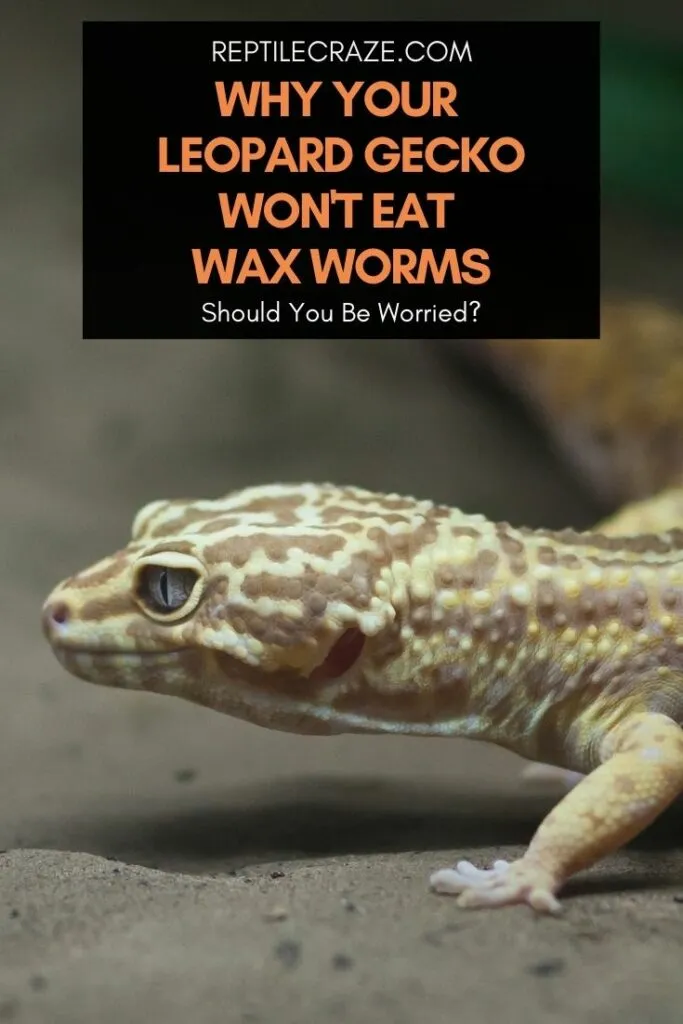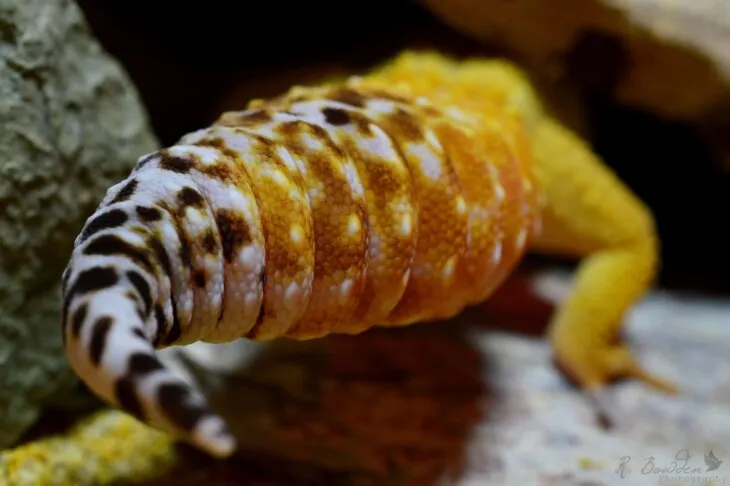
Leopard Geckos (Eublepharis macularius) usually chow down on wax worms (Galleria mellonella) like a kid in a candy store. Therefore, it can be worrying when your Leopard Gecko won’t eat this delicious treat. So, why might a Leopard Gecko refuse wax worms?
Leopard Geckos may refuse to eat wax worms because they have eaten enough and are satiated. They may refuse to eat wax worms because they dislike them, but this is unusual. They may refuse to eat wax worms because they aren’t eating well in general, are too cold, or suffering from an illness.
Read on to find out more about why your Leopard Gecko won’t eat wax worms, and discover whether the size of his tail could be a factor…
1. Your Leopard Gecko Won’t Eat Wax Worms Because It Is Full
Leopard Geckos are a bit more sensible than some pet lizards about self-managing their
Of course, there are individuals who will eat well beyond the amount they should be eating.
As Leopard Geckos are fairly good at sensing when they are satiated, being full could be the reason that your Leopard Gecko won’t eat his wax worms.
But, it still isn’t advisable to assume that your Leopard Gecko will be responsible and stop taking wax worms when they have eaten enough. To learn how many wax worms Leopard Geckos should eat, check out our guide here.
2. Your Leopard Gecko Doesn’t Like Wax Worms
Most Leopard Geckos love wax worms, so it is unlikely that they will refuse to eat them simply because they don’t like them. But, every individual is different, so this can happen.
3. Your Leopard Gecko Refuses To Eat Wax Worms Because It’s A Picky Eater
Sometimes, Leopard Geckos go through phases of being picky eaters and it is difficult to get them to take feeder insects.
Note: We have created a guide on how to feed leos that are picky eaters here.
If your Leopard Gecko is very underweight as a result, he needs to get some extra calories in his diet. If he is a hatchling or juvenile who is refusing to try any feeder insects, then you need to offer very enticing
Wax worms are a highly delicious feeder insect and one with a lot of calories from fat. So, you can use wax worms to stimulate your Leopard Gecko’s appetite.
Try choosing a very soft, plump worm that is easy to eat. You can even slice it open a little so that the juicy insides spill out, to tempt your Leopard Gecko even more.
Once you have got your Leopard Gecko taking wax worms, you can craftily switch in more nutritious feeder insects. For example, soft mealworms and later dubia roaches. Ensure you dust your feeder insects to increase their nutritional value.
Wax worms should not be part of your Leopard Gecko’s staple diet long-term. They are very calorific, high in phosphorus compared to calcium, and have very little nutritional value besides fat.
They are akin to cookies, and should only be used as a treat, or for purposefully kickstarting your pet’s appetite or packing on weight.
4. Your Leopard Gecko Won’t Eat Wax Worms Because It Is Too Cold
When Leopard Geckos stop eating, the first thing to check is whether they are warm enough. Lots of Leopard Geckos stop eating when temperatures drop.
A simple fix is to make sure that the warm area of your Leopard Gecko habitat is above 26 degrees Celsius or 80 degrees Fahrenheit.
5. If A Leopard Gecko Doesn’t Eat Wax Worms, It Might Be Sick
Another reason that Leopard Geckos may refuse even the most delicious wax worms is that they are unwell.
Some illnesses cause Leopard Geckos to stop eating. For example, impaction, metabolic bone disease, and fatty liver syndrome.
Note: If your leo doesn’t eat at all, read this article. It will help you to find out what the problem is.
Impaction
Impaction is caused when a lump of
This will cause constipation so you won’t see your pet toileting properly. He will not be able to absorb any nutrients from his
Metabolic Bone Disease (MBD)
Metabolic bone disease, also called MBD, is another common illness. MBD occurs when your leopard gecko gets too much phosphorus and not enough calcium and vitamin D.
As a result, his body will draw calcium from his bones. This causes his skeleton to become weakened and deformed. A symptom of MBD is that your Leopard Gecko will stop eating.
Hepatic Lipidosis (Fatty Liver Syndrome)
Hepatic Lipidosis, commonly called fatty liver syndrome, results from overfeeding and obesity. It causes the liver to stop functioning correctly.
As a result, the symptoms are actually rapid weight loss, and that your Leopard Gecko will stop eating.
Will Your Leopard Gecko Refuse To Eat Wax Worms When It Has Enough Energy Stored In Its Tail?
Leopard Geckos store up fat in their tails. This is a survival technique that allows them to survive for up to a month without
But, the fat store is for survival emergencies only. Leopard Geckos don’t spontaneously starve themselves for weeks. Nor should you withhold
Leopard Geckos don’t reach a point where their tails are fat enough, and then stop eating until they’re skinny again.
They will continue eating to nourish their bodies, and store extra nutrients in their tails to maintain them. So, having a fat tail is unlikely to be a reason that your Leopard Gecko won’t eat wax worms.
Maintaining a fat tail is a good sign that your Leopard Gecko is receiving enough
But, it does not follow that you should continue to feed an overweight Leopard Gecko too many calories. If you notice signs of obesity you need to control their calories more carefully.
Signs of obesity include fat bubbles in the armpits, belly fat rolls, or a slow waddling walk.

Should Your Leopard Gecko Eat Wax Worms Anyway?
Wax worms are perfectly safe for your Leopard Gecko to eat. But, some Leopard Geckos can become very choosy. They may only want to eat delicious wax worms rather than their staple feeder insects.
Waxworms are high in fat and not very nutritious. Feeding excessive wax worms can contribute to diseases such as obesity and metabolic bone disorder.
Discover all the details to consider about whether Leopard Geckos can and should eat wax worms by reading our in-depth guide.
- Enchi Ball Python: A Unique and Stunning Morph of Python regius - March 27, 2025
- Emerald Tree Monitor: The Enigmatic Green Guardian of the Rainforest - March 26, 2025
- The Egyptian Cobra (Naja haje): A Fascinating Serpent - March 25, 2025
